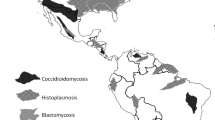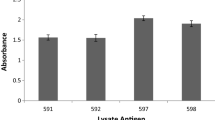Abstract
An immunodiffusion test was developed for the diagnosis of basidiobolomycosis. When culture filtrate antigen (CFA) from Basidiobolus ranarum was reacted against two human patient and two rabbit antisera, 2 precipitin bands, inner (N) and outer (Y), were revealed for both patient and rabbit antisera. A line of identity was also observed between precipitin bands obtained with patient and rabbit sera. When CFA from B. ranarum (B CFA) was reacted against rabbit sera which contained antibody to Conidiobolus coronatus and Pythium insidiosum, 1 precipitin band corresponding to inner band (N) was observed. This finding showed that B. ranarum, C. coronatus and P. insidiosum shared at least one common antigen. After B CFA was absorbed with Pythium rabbit antiserum, the inner precipitin line that occurred between B CFA and rabbit antisera of Pythium and Conidiobolus disappeared. However, with Basidiobolus rabbit antiserum, the result did not change. The antigens which could be demonstrated by inner (N) and outer (Y) precipitin bands were heat stable at 56 ° C for 30 min. The titer of the antibodies specific to these antigens decreased as the lesions subsided. When B. ranarum CFA was reacted against sera from 20 apparently normal persons, 20 diabetes mellitus patients, 5 aspergillosis patients, 2 candidosis patients and 3 pythiosis patients, no precipitin band was found. B. ranarum CFA was also treated with each rabbit antiserum specific to Candida albicans, Malassezia furfur and Aspergillus fumigatus. No precipitin bands occurred with any of these antisera. Thus, this test was found to be practical, sensitive and specific, and can be used to monitor patients infected with Basidiobolus ranarum.
Similar content being viewed by others
References
Joe LK, Njo-Tioei E, Pohon A, Van der Meulen A, Emmons CW. Basidiobolus ranarum as a cause of subcutaneous mycoses in Indonesia. Arch Dermatol 1956; 74: 378–83.
Chantarakul N, Talalak P, Vareenil J. Phycomycosis. J. med Ass Thailand 1965; 48: 740–9.
Thasnakorn P, Sribooma V, Chantarakul N, Bhadrakom S. Subcutaneous mycosis due to Basidiobolus meristosporus: report of a case. J. Med Ass Thailand 1969; 52: 372–7.
Thianprasit M. Subcutaneous phycomycosis in Thailand. 5th Int Congr of Infectious Diseases (Vienna). Separatum 1970; 43-45-A 11/3-5.
Imwidthaya S, Plangpatanapanichya A. Sripathomswat N. Basidiobolus in Toad's excreta in Thailand. J. Med Ass Thailand 1982; 65: 420–5.
Rippon JW. Medical mycology, 2nd ed. Philadelphia: WB Saunders Comp 1982: 303–14.
Jones KW, Kaufman L. Development and evaluation of an immunodiffusion test for diagnosis of systemic zygomycosis (mucormycosis): preliminary report. J Clin Microbiol 1978; 7: 97–101.
Yangco BG, Nettlow A, Okafor JI, Park J, Te-Strake D. Comparative antigenic studies of species of Basidiobolus and other medically important fungi. J Clin Microbiol 1986; 34: 679–82.
Thianprasit M. Cutaneous Pythiosis in Human-Being. Abstract in Siriraj 100th Academic Meeting, Mahidol University. Bangkok, Thailand, 18–22 April 1988: 94.
Kaufman L, Mendoza L, Standard PG. Immunodiffusion test for serodiagnosing subcutaneous zygomycosis. J Clin Microbiol 1990; 28: 1887–1890.
Author information
Authors and Affiliations
Rights and permissions
About this article
Cite this article
Imwidthaya, P., Srimuang, S. Immunodiffusion test for diagnosing basidiobolomycosis. Mycopathologia 118, 127–131 (1992). https://doi.org/10.1007/BF00437144
Received:
Accepted:
Issue Date:
DOI: https://doi.org/10.1007/BF00437144




